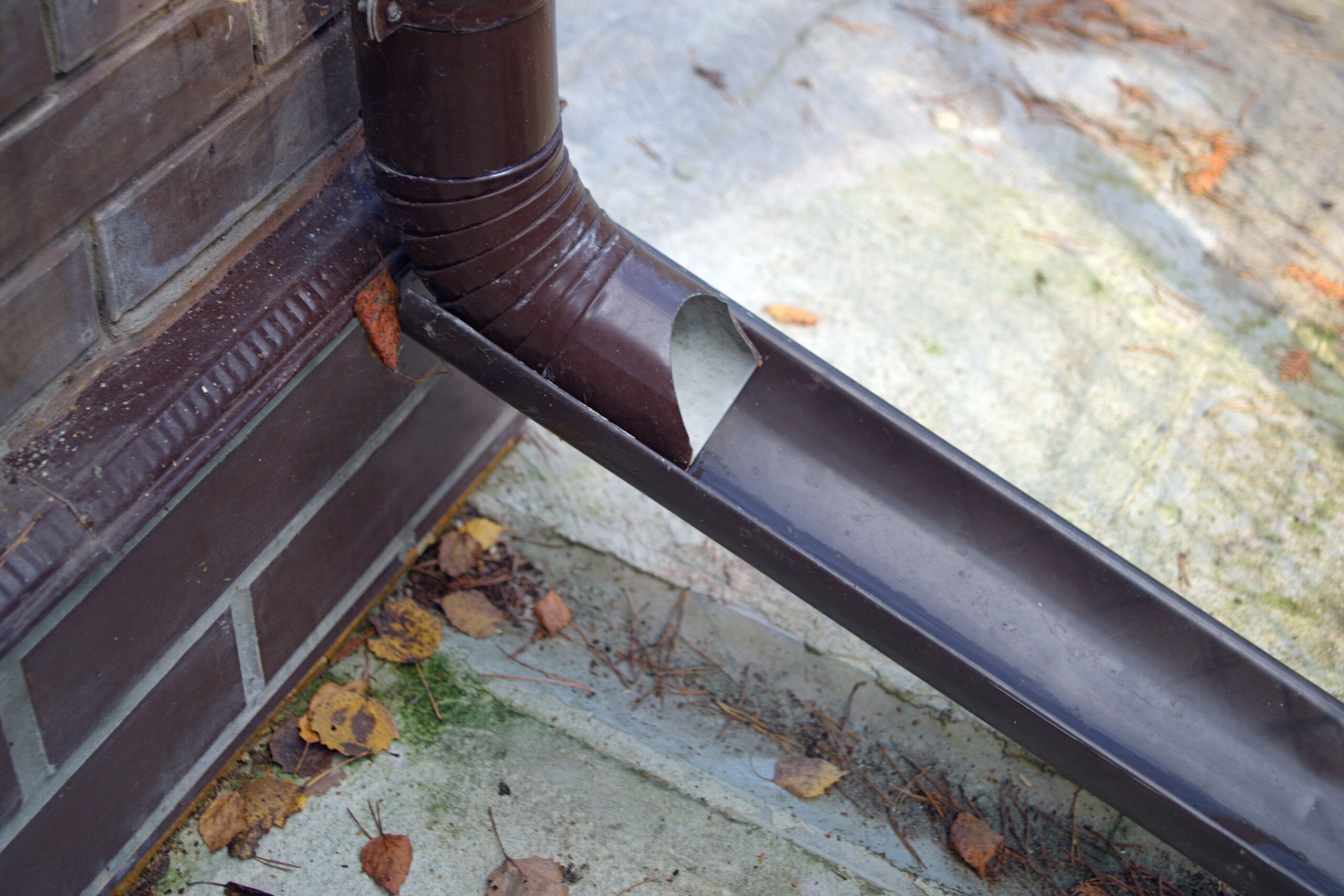Gutters and downspouts help control water runoff from your roof. But if the rain or melted snow isn’t carried far enough away from the house, it can collect against the foundation wall or footing and seep into your basement or crawl space.
Extending your downspouts is an effective way to prevent this problem. In some cases, the project is as simple as mounting some cheap downspout extenders that will carry the rainwater a few extra feet. However, some homes may need a system that funnels water into underground drainage lines that will funnel water far away from your foundation. This type of project is a lot more complicated—and expensive.
Our guide provides step-by-step instructions and tips for successfully extending your downspouts underground and guidance on when it may be better to call a professional.
Understanding Downspout Extensions
Standard gutter downspouts may not carry water far enough to protect your home. In this case, downspout extensions enhance your gutter system to prevent water from pooling around your home’s foundation, a serious issue that can cause basement flooding, foundation cracks, and soil erosion. Proper drainage not only safeguards your home’s structural integrity but also protects your landscaping and prevents mosquitos.
Types of Downspout Extensions
There are several types of downspout extensions available, each suited to different needs and preferences:
- Above-ground extensions: These attachments sit above ground and extend from the bottom of the downspout. They’re easily found at big-box hardware stores and are the easiest solution.
- Underground extensions: These installations involve burying PVC pipes to carry water away from the house, offering more discreet drainage. They’re more difficult to install, since you’ll need to dig trenches to bury the pipes.
- Flexible extensions: These extensions can be easily moved, making them ideal for temporary installations.
- Decorative extensions: These extensions use themed decorative elements that add visual interest to your yard.
For this guide, we’ll focus primarily on installing underground extensions, as they offer a permanent, aesthetically pleasing solution for most homes.
Planning Your Downspout Extension Project
Before you start excavating trenches and installing pipes, doing some planning will help you avoid obstacles and ensure that your extension works efficiently. Below, we’ve listed key elements to consider during the planning phase.
Assess Your Drainage Needs
Start by observing how water flows around your property during rainfall. Identify low spots where water tends to collect and determine the best direction to channel the water. Consider factors such as the slope of your yard, existing landscaping, and any areas you want to keep dry. You should also avoid directing water onto your neighbor’s property or toward other structures.
Measure and Map Your Extension Route
Once you’ve determined the best direction for water flow, measure the distance from your downspout to the desired drainage point. Use stakes and string to lay out the proposed route, marking any turns or obstacles. This will help you calculate the amount of materials needed and identify any potential challenges in the installation process.
Downspout Tools and Materials Needed
You’ll need the following tools and materials to complete your downspout extension project.
Tools
- Shovel or trenching tool
- String and stakes
- Tape measure
- Hacksaw or power miter saw
- Level
- Marking paint or flour
- Protective eyewear
- Garden hoe
Materials
- 4-inch diameter non-perforated Schedule 40 PVC pipe
- Flexible drainpipe (for navigating obstacles)
- PVC elbows, T-fittings, and couplings
- Downspout adapters and reducer couplings
- PVC primer and cement
- Gravel or flat rocks
- Cardboard
The amount of materials needed will depend on the length and complexity of your extension. It’s always a good idea to purchase 10%–15% more materials to account for unforeseen issues or mistakes.
How to Extend Your Downspout
Here’s a step-by-step breakdown of the downspout extension installation process.
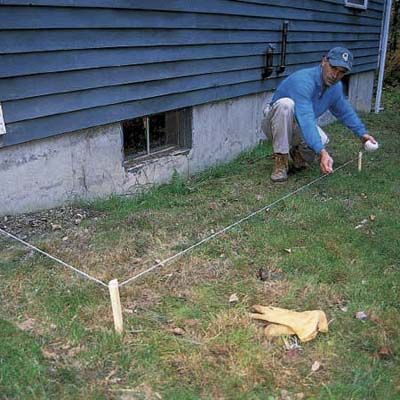
Step 1: Lay Out and Mark the Trench Line
Start by laying out the trench using string and 1×2 stakes. Place stakes 4 feet from the house directly in front of each downspout, with additional stakes spaced 8 feet apart along the planned route.
Tie a string to the downspout and stretch it around all the stakes to create a clear path. Sprinkle flour or use marking paint along the string to make the trench line visible.
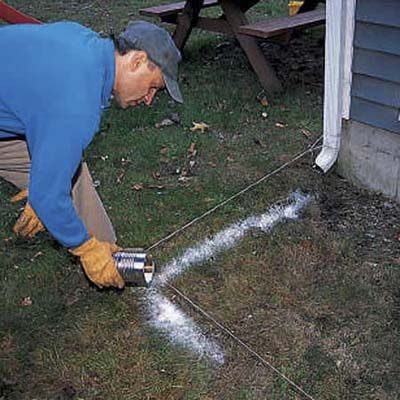
Step 2: Dig the Trench
Before digging, place cardboard along the edge of your trench line. As you remove soil, place it on the cardboard. This makes backfilling much easier later on. The trench should be at least 6 inches wide and 10 inches deep, sloping slightly downward away from the house. To ensure proper drainage, aim for a drop of 1—2 inches per length of pipe.
Digging can be time-consuming, depending on your soil type and trench length. For our installation, we dug a 70-foot-long trench by hand through rocky soil, a job that took three weekends.
For particularly hard soil or for longer trenches, consider renting a trenching machine. However, if you’ve never used one before or are uncomfortable handling excavation equipment, we recommend hiring a backhoe operator to handle this part of the process.
Finally, lay out all the pipe lengths and fittings next to the trench to ensure you have all the necessary parts.
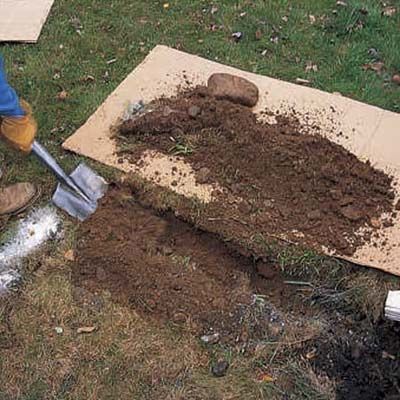
The trench must be at least 10 inches deep, but be aware that in cold-weather regions, the pipe occasionally will clog with ice during periods of heavy precipitation. This condition most often occurs when the air temperature is mild during the day but drops below freezing at night.
Tip: The only guaranteed way to keep the pipe from freezing is to bury it below the frost line, which ranges between 32 and 48 inches in most areas of the snow belt. Digging a trench that deep is only practical when the end of the pipe drains into a dry well or is connected to an existing drain line.
Step 3: Lay out the Pipe Lengths and Fittings
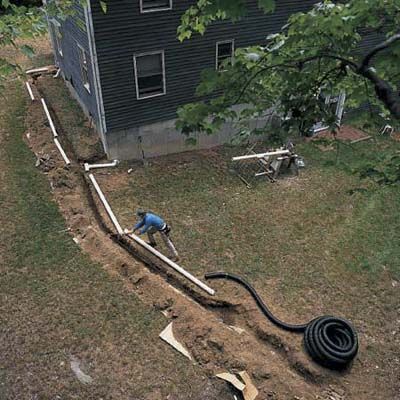
Lay out all the pipe lengths and fittings beside the trench to make sure you’ve got all the necessary parts.
Step 4: Connect the Adapter and Reducer
Begin by connecting a downspout adapter to a 3×4-inch reducer coupling. This assembly will allow you to transition from your existing downspout to the new drainage pipe. Slip this adapter assembly onto the bottom of your downspout, but don’t glue it yet—you’ll want some flexibility for the final adjustments.
Next, place a 90-degree elbow in the trench directly below the coupling. Measure the distance between these two fittings and cut a piece of PVC pipe to fit. Cut with a handsaw, hacksaw, or 12-inch power miter saw. Apply PVC primer and cement to both the pipe and the elbow, then press them together with a slight twist. Hold for a few seconds to allow the cement to set. The cement cures in just a few seconds.

Step 5: Lay and Connect Pipes
Continue laying pipe along the trench, using couplings to connect sections as needed. Remember to maintain a slight downward slope as you go. Use a level to check that each section slopes away from the house.
When you reach turns in your layout, use appropriate elbows or flexible pipes to navigate around obstacles. For sharp turns, use 90-degree elbows. For gentler curves, you can use a flexible drainpipe.
Secure the flexible pipe to rigid PVC sections using a 3×4-inch reducer coupling and a stainless-steel pipe clamp. This combination of rigid and flexible piping allows you to create a drainage system that effectively navigates your yard’s unique landscape.
Continue installing pipes along the trench until you reach the second downspout. Use standard couplings to connect the pipe sections.
Step 6: Connect Your Second Downspout
When connecting a second downspout to your drainage system, install the adapter and reducer assembly as you did for the first one.
When this new line meets the existing pipe, glue a sanitary T-fitting to the pipe end and the other end of its trench. Ensure the curved elbow of the T-fitting faces “downstream” to facilitate smooth water flow.
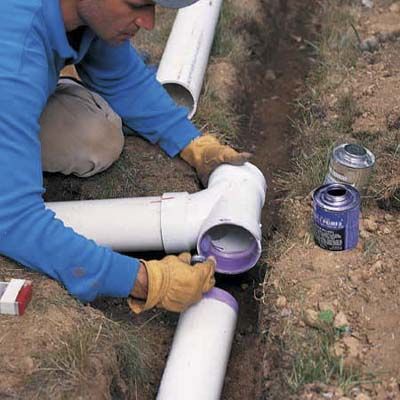
Step 7: Backfill the Trench
Once all pipes are connected and you’ve verified that the system is working correctly, it’s time to backfill the trench. Use a garden hoe to pull the soil from the cardboard back into the trench, covering the pipes completely. Tamp down the soil as you go to prevent future settling. Once the trench is filled, replace any sod or landscaping materials you removed during the digging process.
Step 8: Create a Drainage Point
At the end of your drainage system, create a proper exit point for the water. Dig a wide, shallow hole approximately 16 inches deep and 36 inches in diameter at the end of the trench. Line this area with flat rocks or a 4-inch layer of gravel. This will help disperse the water and prevent erosion at the outlet. Lay the end of your pipe on this bed of rocks or gravel, then cover it with additional rocks or gravel.
Alternative Downspout Extension Methods
While underground extensions offer a permanent and aesthetically pleasing solution, they’re not the only option for managing downspout runoff. If an underground system isn’t right for your situation, consider these alternatives.
Above-Ground Extensions
Above-ground extensions provide a simpler, more affordable alternative to underground installations. These can be rigid or flexible and typically extend 4—5 feet from the base of the downspout. They’re easy to install and can be moved as needed, making them ideal for temporary solutions or renters who can’t make permanent changes to the property.
However, above-ground extensions can be tripping hazards and may interfere with lawn maintenance. They also tend to be less durable and more visible than underground systems.
Rain Barrels and Water Collection
Rain barrels offer an eco-friendly alternative to traditional extensions. These systems collect rainwater from your downspouts, which can be used to water gardens or lawns during dry periods. When installing a rain barrel system, ensure an overflow mechanism directs excess water away from your foundation when the barrel is full. This could be an above-ground extension or an underground drainage system connection.
DIY vs. Professional Extension Installation
DIY installation is generally less expensive, with materials ranging from $250–$500 for an average-sized home to extend two downspouts underground. This includes pipes, fittings, and necessary tools. However, if you need to rent equipment like a trenching machine, you could spend up to $100 per day for rental costs.
According to Angi, professional installation can cost $2,000 or more, depending on the job’s complexity and your location. While more expensive, professional installation ensures proper slope and connection and can be completed more quickly.
Consider these factors when budgeting for your project, and always get multiple quotes if opting for professional installation.
Maintenance and Troubleshooting for Downspouts
Regular maintenance and occasional troubleshooting are necessary to ensure your newly extended downspouts continue to function effectively. Proper care will extend your system’s life and prevent water-related issues around your home.
Regular Downspout Inspection
Visually inspect your downspouts and extensions at least twice a year, ideally in spring and fall. Look for these potential issues:
- Cracks or separations in the pipes
- Loose connections at joints or fittings
- Signs of water backing up or pooling near the house
- Debris accumulation at the drainage point
Additionally, during heavy rainfall, observe how water flows through the system to ensure it’s working as intended.
Dealing with Gutter Clogs and Freezing
Clogs can occur due to leaves, twigs, or other debris entering the system. To prevent this, regularly clean your gutters or invest in a gutter guard system such as LeafFilter or LeafGuard. If you suspect a clog, you can often clear it using a plumber’s snake or by flushing the system with a garden hose.
Freezing can be a concern in colder climates. While burying pipes below the frost line is the best prevention, this isn’t always practical. For pipes closer to the surface, consider using heat tape in problem areas or temporarily disconnecting above-ground sections during the coldest months.
Our Conclusion
Proper water drainage is crucial for your home’s integrity. Extending your downspouts is necessary in some cases and can be completed as a DIY project or by hiring a professional. Regular inspection and maintenance will ensure the system continues to function effectively. By taking action now, you safeguard your home against potential water-related issues for years to come.
